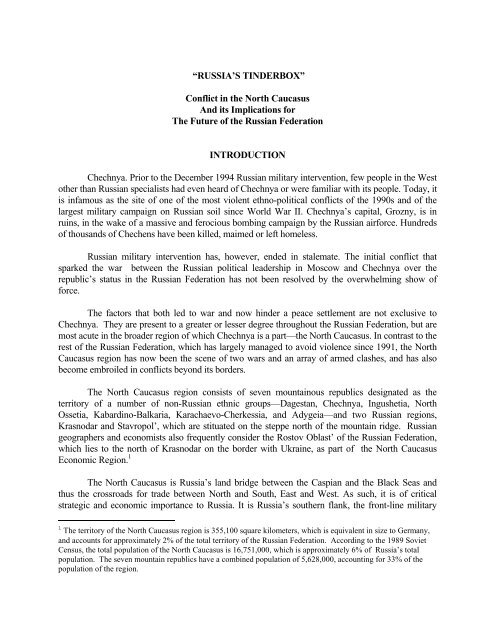RUSSIA'S TINDERBOX - Belfer Center for Science and International ...
RUSSIA'S TINDERBOX - Belfer Center for Science and International ...
RUSSIA'S TINDERBOX - Belfer Center for Science and International ...
You also want an ePaper? Increase the reach of your titles
YUMPU automatically turns print PDFs into web optimized ePapers that Google loves.
“RUSSIA’S <strong>TINDERBOX</strong>”<br />
Conflict in the North Caucasus<br />
And its Implications <strong>for</strong><br />
The Future of the Russian Federation<br />
INTRODUCTION<br />
Chechnya. Prior to the December 1994 Russian military intervention, few people in the West<br />
other than Russian specialists had even heard of Chechnya or were familiar with its people. Today, it<br />
is infamous as the site of one of the most violent ethno-political conflicts of the 1990s <strong>and</strong> of the<br />
largest military campaign on Russian soil since World War II. Chechnya’s capital, Grozny, is in<br />
ruins, in the wake of a massive <strong>and</strong> ferocious bombing campaign by the Russian air<strong>for</strong>ce. Hundreds<br />
of thous<strong>and</strong>s of Chechens have been killed, maimed or left homeless.<br />
Russian military intervention has, however, ended in stalemate. The initial conflict that<br />
sparked the war between the Russian political leadership in Moscow <strong>and</strong> Chechnya over the<br />
republic’s status in the Russian Federation has not been resolved by the overwhelming show of<br />
<strong>for</strong>ce.<br />
The factors that both led to war <strong>and</strong> now hinder a peace settlement are not exclusive to<br />
Chechnya. They are present to a greater or lesser degree throughout the Russian Federation, but are<br />
most acute in the broader region of which Chechnya is a part––the North Caucasus. In contrast to the<br />
rest of the Russian Federation, which has largely managed to avoid violence since 1991, the North<br />
Caucasus region has now been the scene of two wars <strong>and</strong> an array of armed clashes, <strong>and</strong> has also<br />
become embroiled in conflicts beyond its borders.<br />
The North Caucasus region consists of seven mountainous republics designated as the<br />
territory of a number of non-Russian ethnic groups—Dagestan, Chechnya, Ingushetia, North<br />
Ossetia, Kabardino-Balkaria, Karachaevo-Cherkessia, <strong>and</strong> Adygeia—<strong>and</strong> two Russian regions,<br />
Krasnodar <strong>and</strong> Stavropol’, which are stituated on the steppe north of the mountain ridge. Russian<br />
geographers <strong>and</strong> economists also frequently consider the Rostov Oblast’ of the Russian Federation,<br />
which lies to the north of Krasnodar on the border with Ukraine, as part of the North Caucasus<br />
Economic Region. 1<br />
The North Caucasus is Russia’s l<strong>and</strong> bridge between the Caspian <strong>and</strong> the Black Seas <strong>and</strong><br />
thus the crossroads <strong>for</strong> trade between North <strong>and</strong> South, East <strong>and</strong> West. As such, it is of critical<br />
strategic <strong>and</strong> economic importance to Russia. It is Russia’s southern flank, the front-line military<br />
1 The territory of the North Caucasus region is 355,100 square kilometers, which is equivalent in size to Germany,<br />
<strong>and</strong> accounts <strong>for</strong> approximately 2% of the total territory of the Russian Federation. According to the 1989 Soviet<br />
Census, the total population of the North Caucasus is 16,751,000, which is approximately 6% of Russia’s total<br />
population. The seven mountain republics have a combined population of 5,628,000, accounting <strong>for</strong> 33% of the<br />
population of the region.
















